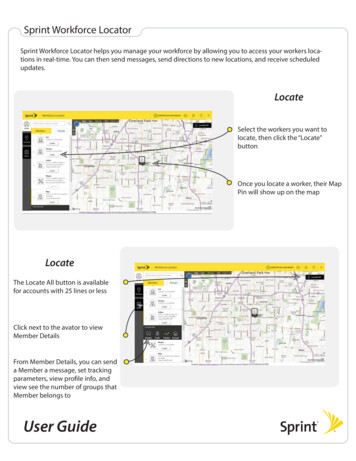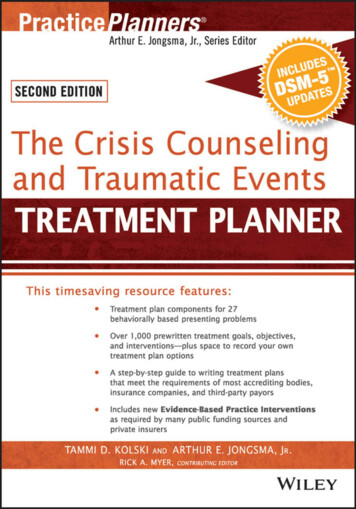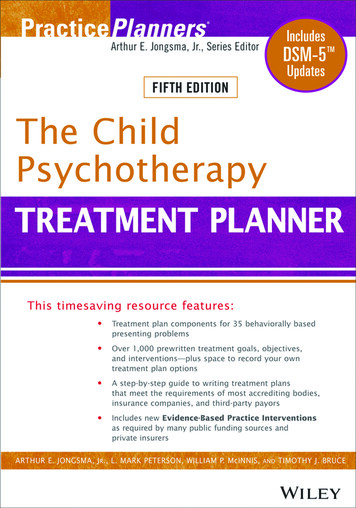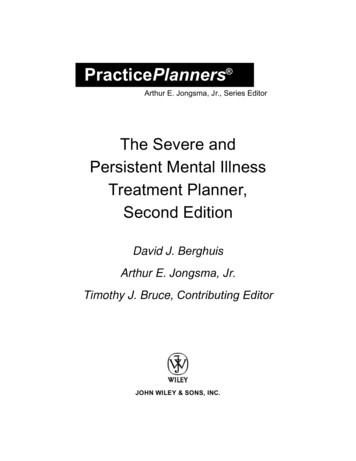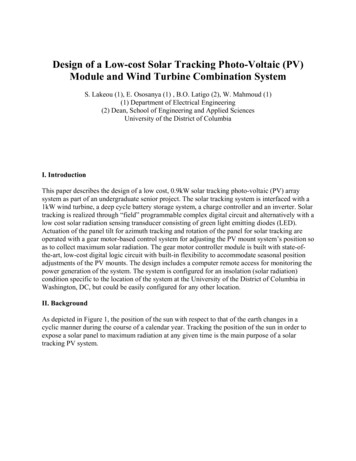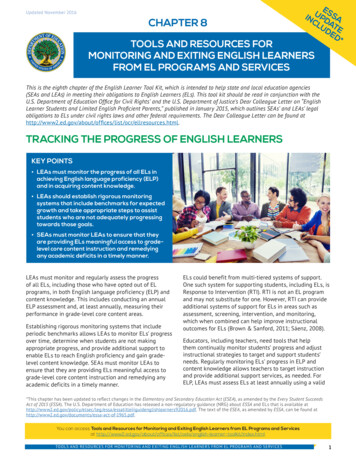
Transcription
Updated November 2016ESUIN PD SACL AUD TEED*Updated November 2016CHAPTER 8TOOLS AND RESOURCES FORMONITORING AND EXITING ENGLISH LEARNERSFROM EL PROGRAMS AND SERVICESThis is the eighth chapter of the English Learner Tool Kit, which is intended to help state and local education agencies(SEAs and LEAs) in meeting their obligations to English Learners (ELs). This tool kit should be read in conjunction with theU.S. Department of Education Office for Civil Rights’ and the U.S. Department of Justice’s Dear Colleague Letter on “EnglishLearner Students and Limited English Proficient Parents,” published in January 2015, which outlines SEAs’ and LEAs’ legalobligations to ELs under civil rights laws and other federal requirements. The Dear Colleague Letter can be found ources.html.TRACKING THE PROGRESS OF ENGLISH LEARNERSKEY POINTS LEAs must monitor the progress of all ELs inachieving English language proficiency (ELP)and in acquiring content knowledge. LEAs should establish rigorous monitoringsystems that include benchmarks for expectedgrowth and take appropriate steps to assiststudents who are not adequately progressingtowards those goals. SEAs must monitor LEAs to ensure that theyare providing ELs meaningful access to grade level core content instruction and remedyingany academic deficits in a timely manner.LEAs must monitor and regularly assess the progressof all ELs, including those who have opted out of ELprograms, in both English language proficiency (ELP) andcontent knowledge. This includes conducting an annualELP assessment and, at least annually, measuring theirperformance in grade-level core content areas.Establishing rigorous monitoring systems that includeperiodic benchmarks allows LEAs to monitor ELs’ progressover time, determine when students are not makingappropriate progress, and provide additional support toenable ELs to reach English proficiency and gain grade level content knowledge. SEAs must monitor LEAs toensure that they are providing ELs meaningful access tograde-level core content instruction and remedying anyacademic deficits in a timely manner.ELs could benefit from multi-tiered systems of support.One such system for supporting students, including ELs, isResponse to Intervention (RTI). RTI is not an EL programand may not substitute for one. However, RTI can provideadditional systems of support for ELs in areas such asassessment, screening, intervention, and monitoring,which when combined can help improve instructionaloutcomes for ELs (Brown & Sanford, 2011; Sáenz, 2008).Educators, including teachers, need tools that helpthem continually monitor students’ progress and adjustinstructional strategies to target and support students’needs. Regularly monitoring ELs’ progress in ELP andcontent knowledge allows teachers to target instructionand provide additional support services, as needed. ForELP, LEAs must assess ELs at least annually using a valid*This chapter has been updated to reflect changes in the Elementary and Secondary Education Act (ESEA), as amended by the Every Student SucceedsAct of 2015 (ESSA). The U.S. Department of Education has released a non-regulatory guidance (NRG) about ESSA and ELs that is available leiiiguidenglishlearners92016.pdf. The text of the ESEA, as amended by ESSA, can be found f.You can access Tools and Resources for Monitoring and Exiting English Learners from EL Programs and Servicesat -learner-toolkit/index.html.TOOLS AND RESOURCES FOR MONITORING AND EXITING ENGLISH LEARNERS FROM EL PROGRAMS AND SERVICES1
Updated November 2016and reliable assessment that is aligned to state ELPstandards. In addition, periodic formative assessmentsof ELP help inform instruction and support ELs’ Englishlanguage development throughout the school year.EL progress should inform EL program evaluations. SeeChapter 9 of this tool kit for information on evaluating theeffectiveness of an LEA’s EL program.EXITING ENGLISH LEARNERSKEY POINTS LEAs must document that an EL hasdemonstrated English proficiency using a validand reliable ELP assessment that tests all fourlanguage domains. Students exiting from EL status must bemonitored for at least two years, to ensurethat (1) they have not been prematurely exited;(2) any academic deficits incurred as a resultof participating in the EL program have beenremedied; and (3) they are meaningfullyparticipating in the standard program ofinstruction comparable to their never-EL peers. In addition, the ESEA now requires LEAsto report on the number and percentage offormer ELs meeting state academic standardsfor four years.SEAs must use valid and reliable ELP assessments thattest all four language domains (listening, speaking,reading, and writing) to ensure that ELs have achievedEnglish proficiency. The proficiency score on the ELPassessment must be set at a level that enables students toeffectively participate in grade-level content instructionin English without EL services. This does not mean thatstudents must score proficient on a content assessment(e.g., reading/language arts) in order to exit EL status;indeed, there are never-EL students who are in thegeneral education program who do not score proficient onthese content assessments.SEAs may use additional objective criteria relatedto English proficiency to decide if an EL who scoresproficient on the ELP assessment is ready to exit ELservices. However, these additional criteria may notsubstitute for a proficient score on a valid and reliableELP assessment.Exiting EL students either too soon or too late raisescivil rights concerns. EL students who are exited toosoon are denied access to EL services while EL studentswho are exited too late may be denied access to partsof the general curriculum. Denied or delayed access tothe general curriculum can impede academic growth andcontribute to a higher risk of dropping out of school.After students have exited an EL program, LEAs mustmonitor their academic progress for at least two years. Ifan exited EL is not progressing academically as expectedand monitoring suggests a persistent language need,LEAs should re-test the student’s ELP with a valid,reliable, and grade-appropriate ELP test to see if thestudent must be offered additional language assistanceservices. In no case should re-testing of an exitedstudent’s ELP be prohibited. If the student is reenteredinto EL services, however, the LEA should document thereasons why and the parent’s consent to reentry. If SEAsor LEAs find that changes to exit criteria or procedures arenecessary, SEAs and LEAs need to provide teachers andstaff with appropriate training.ESSA UPDATEUnder Title III of the ESEA, as amended byESSA [Section 3121(a)(5)], LEAs must reporton the number and percentage of former ELsmeeting state standards for four years. Formore information, see section J of the NRG (U.S.Department of Education, Office of Elementaryand Secondary Education, 2016). In addition, theESEA [Section 3113(b)(2)] requires standardizedstatewide entrance and exit procedures for ELs.The following checklist is intended to assist with trackingthe progress of ELs and exiting ELs. The checklistprovides suggested questions only. Schools and LEAsshould check their SEA’s policies and federal guidance toensure compliance.Tracking the Progress of ELs Are all ELs, including those who have opted out of ELprograms and services, monitored at least annuallyfor progress in achieving ELP and acquiring contentknowledge?You can access Tools and Resources for Monitoring and Exiting English Learners from EL Programs and Servicesat -learner-toolkit/index.html.2TOOLS AND RESOURCES FOR MONITORING AND EXITING ENGLISH LEARNERS FROM EL PROGRAMS AND SERVICES
Updated November 2016 Are LEAs monitoring ELs’ progress toward establishedbenchmarks for expected growth in ELP and thegrade-level content areas and assisting students whoare not making timely progress towards those goals? Does the SEA monitor LEAs to ensure that they areboth providing ELs meaningful access to grade-levelcore content instruction and remedying any academicdeficits in a timely manner? Has the SEA developed ELP standards and ensuredthat LEAs are implementing those ELP standards toinform EL programs, services, and assessments?Exiting ELs Are procedures in place to ensure that students exitfrom EL programs, services, and status only afterthey demonstrate English proficiency on a valid andreliable ELP assessment? What processes are in place to monitor the progress offormer ELs? Do LEAs monitor, for at least two years,the academic progress of students who have exited ELstatus to ensure that they have not been prematurelyexited and that they are meaningfully participating inthe LEA’s standard educational programs comparableto their never-EL peers?You can access Tools and Resources for Monitoring and Exiting English Learners from EL Programs and Servicesat -learner-toolkit/index.html.TOOLS AND RESOURCES FOR MONITORING AND EXITING ENGLISH LEARNERS FROM EL PROGRAMS AND SERVICES3
Updated November 2016MONITORING AND EXITING ENGLISH LEARNERSFROM EL PROGRAMS AND SERVICESTOOLSThe U.S. Department of Education does not mandate or prescribe particular curricula, lesson plans, assessments, or otherinstruments in this tool kit. This tool kit contains examples of, adaptations of, and links to some resources created andmaintained by other public and private organizations. This information is provided for the reader’s convenience and is includedhere to offer examples of the many resources that educators, parents, advocates, administrators, and other interested partiesmay find helpful to use at their discretion. The U.S. Department of Education does not control or guarantee the accuracy,relevance, timeliness, or completeness of this outside information. Further, the inclusion of links to items does not reflect theirimportance, nor is it intended to endorse any views expressed, or materials provided. All links verified on August 25, 2015.The following tools are intended to assist schools, LEAs, and SEAs in establishing rigorous monitoring systems thatinclude benchmarks for expected growth and taking appropriate steps to assist students who are not adequatelyprogressing towards those benchmarks.Tool #1, Monitoring English Learner Progress in EnglishLanguage Proficiency, is an example of a monitoring formthat can help determine if an EL is making appropriateprogress, or needs additional support to attain Englishproficiency.Tool #2, Monitoring English Learner Progress in CoreContent Areas, is an example of a form that can help trackan EL’s educational progress in the content areas.Tool #3, Digital Progress Monitoring, provides examplesof five digital systems available online to monitor ELs’progress.Tool #4, Resources for Planning and Self-Assessments,provides reference tools, materials, and resources fromthe Office for Civil Rights (OCR).You can access Tools and Resources for Monitoring and Exiting English Learners from EL Programs and Servicesat -learner-toolkit/index.html.4TOOLS AND RESOURCES FOR MONITORING AND EXITING ENGLISH LEARNERS FROM EL PROGRAMS AND SERVICES
Updated November 2016The EL Tool Kit contains examples of, adaptations of, and links to resources created and maintained by other public and private organizations.This information is provided for the reader’s convenience and is included here to offer examples of the many resources that educators, parents,advocates, administrators, and other interested parties may find helpful and use at their discretion. The U.S. Department of Education does notcontrol or guarantee the accuracy, relevance, timeliness, or completeness of this outside information. Further, the inclusion of links to items doesnot reflect their importance, nor is it intended to endorse any views expressed, or materials provided.TOOL #1MONITORING ENGLISH LEARNER PROGRESS INENGLISH LANGUAGE PROFICIENCYEducators need tools that will help them continually monitor students’ progress and adjust instructional strategies totarget and support students’ language needs. Such tools must be used in addition to, rather than in lieu of, the annualELP assessment.EL LANGUAGE PROGRESS MONITORING FORMSThe following tool is used with permission from Colorín Colorado’s ELL Starter Kit for Educators: Tools for MonitoringLanguage Skills. It may be helpful to use these forms to monitor ELs in the classroom, to determine if their progress isappropriate or whether they need additional support to attain English proficiency. The form below is an excerpt froma larger document. Additional monitoring forms for oral communication skills, reading and fluency skills, and use ofcomprehension strategies can be found in the starter kit (link provided below). The forms also may help in planning andcommunicating with parents and other teachers.Source: Colorín Colorado. (n.d.). ELL Starter Kit For Educators: Tools for monitoring language skills. Washington, DC: AFT. Retrieved starterkit.pdfYou can access Tools and Resources for Monitoring and Exiting English Learners from EL Programs and Servicesat -learner-toolkit/index.html.TOOLS AND RESOURCES FOR MONITORING AND EXITING ENGLISH LEARNERS FROM EL PROGRAMS AND SERVICES5
Updated November 2016The EL Tool Kit contains examples of, adaptations of, and links to resources created and maintained by other public and private organizations.This information is provided for the reader’s convenience and is included here to offer examples of the many resources that educators, parents,advocates, administrators, and other interested parties may find helpful and use at their discretion. The U.S. Department of Education does notcontrol or guarantee the accuracy, relevance, timeliness, or completeness of this outside information. Further, the inclusion of links to items doesnot reflect their importance, nor is it intended to endorse any views expressed, or materials provided.TOOL #2MONITORING ENGLISH LEARNER PROGRESSIN CORE CONTENT AREASLEAs should create rigorous monitoring systems that include benchmarks for expected growth in acquiring academiccontent knowledge during the academic year and take appropriate steps to assist students who are not adequatelyprogressing towards those goals. Classroom teachers and EL specialists should gather data on EL progress andcollaborate based on this data to ensure that the EL is growing at an acceptable rate in both English languageacquisition and content knowledge.CONTENT MONITORING FORM FOR ENGLISH LEARNERS ORFORMER ENGLISH LEARNERSThe following tool was developed by the National Clearinghouse on English Language Acquisition (NCELA) based ontools used by SEAs and LEAs. This form may be useful to track an EL’s educational progress during the school year. Thetool is meant to be used at team meetings in which classroom teachers and EL specialists (1) review each student’sprogress in mastering academic content standards and meeting benchmarks, and (2) determine the support and servicesan EL may need. This form could also be modified for use in tracking the progress of former ELs during the required two year monitoring period.STUDENT INFORMATIONStudent NameDate of BirthSchool NameDate Entered U.S. SchoolsHome LanguageSTATE CONTENT ASSESSMENT TEST SYear:Grades:Year:Grades:Year:Grades:Is the student on track to graduate on time?Continued on next pageYou can access Tools and Resources for Monitoring and Exiting English Learners from EL Programs and Servicesat -learner-toolkit/index.html.6TOOLS AND RESOURCES FOR MONITORING AND EXITING ENGLISH LEARNERS FROM EL PROGRAMS AND SERVICES
Updated November 2016The EL Tool Kit contains examples of, adaptations of, and links to resources created and maintained by other public and private organizations.This information is provided for the reader’s convenience and is included here to offer examples of the many resources that educators, parents,advocates, administrators, and other interested parties may find helpful and use at their discretion. The U.S. Department of Education does notcontrol or guarantee the accuracy, relevance, timeliness, or completeness of this outside information. Further, the inclusion of links to items doesnot reflect their importance, nor is it intended to endorse any views expressed, or materials provided.TOOL #2: MONITORING ENGLISH LEARNER PROGRESS IN CORE CONTENT AREAS (CONTINUED)CURRENT YEAR BENCHMARKSTerm anguageArtsSubjectOther Term 2BenchmarkTerm 3BenchmarkTerm 4BenchmarkAbove grade levelAbove grade levelAbove grade levelAbove grade levelOn grade levelOn grade levelOn grade levelOn grade levelBelow grade levelBelow grade levelBelow grade levelBelow grade levelAbove grade levelAbove grade levelAbove grade levelAbove grade levelOn grade levelOn grade levelOn grade levelOn grade levelBelow grade levelBelow grade levelBelow grade levelBelow grade levelAbove grade levelAbove grade levelAbove grade levelAbove grade levelOn grade levelOn grade levelOn grade levelOn grade levelBelow grade levelBelow grade levelBelow grade levelBelow grade levelAbove grade levelAbove grade levelAbove grade levelAbove grade levelOn grade levelOn grade levelOn grade levelOn grade levelBelow grade levelBelow grade levelBelow grade levelBelow grade levelAbove grade levelAbove grade levelAbove grade levelAbove grade levelOn grade levelOn grade levelOn grade levelOn grade levelBelow grade levelBelow grade levelBelow grade levelBelow grade levelContinued on next pageYou can access Tools and Resources for Monitoring and Exiting English Learners from EL Programs and Servicesat -learner-toolkit/index.html.TOOLS AND RESOURCES FOR MONITORING AND EXITING ENGLISH LEARNERS FROM EL PROGRAMS AND SERVICES7
Updated November 2016The EL Tool Kit contains examples of, adaptations of, and links to resources created and maintained by other public and private organizations.This information is provided for the reader’s convenience and is included here to offer examples of the many resources that educators, parents,advocates, administrators, and other interested parties may find helpful and use at their discretion. The U.S. Department of Education does notcontrol or guarantee the accuracy, relevance, timeliness, or completeness of this outside information. Further, the inclusion of links to items doesnot reflect their importance, nor is it intended to endorse any views expressed, or materials provided.TOOL #2: MONITORING ENGLISH LEARNER PROGRESS IN CORE CONTENT AREAS (CONTINUED)TEACHER OBSERVATIONSRating Scale: 1: Never 2: Seldom 3: Sometimes 4: Often 5: AlwaysCharacteristicTerm1Term2Term3Term4Completes class assignments on timeParticipates effectively in class discussionsWorks independentlyCompletes homework assignmentsDisplays effortATTENDANCE AND TARDY DATATerm 1Term 2Term 3Term 4AttendanceTardySUMMARY AND ACTION STEPSSummary1.Student meets grade-level academic standards or benchmarks.2.Student does not meet grade-level academic standards or benchmarks. English languageproficiency is not a reason the student is not meeting grade-level academic standards orbenchmarks.3.Student does not meet grade-level academic standards or benchmarks. Limited English languageproficiency in one or more language domains is a reason the student is not meeting grade-levelacademic standards or benchmarks.Action Steps:Date:Person Completing the Form and Title:Team Members:Source: Zantal-Wiener, K., & Bell, T. (2015). Content monitoring form for English learners or former English learners. Silver Spring, MD: NationalClearinghouse for English Language Acquisition (NCELA). Retrieved from http://ncela.ed.gov/files/forms/content monitoring form.pdfYou can access Tools and Resources for Monitoring and Exiting English Learners from EL Programs and Servicesat -learner-toolkit/index.html.8TOOLS AND RESOURCES FOR MONITORING AND EXITING ENGLISH LEARNERS FROM EL PROGRAMS AND SERVICES
Updated November 2016The EL Tool Kit contains examples of, adaptations of, and links to resources created and maintained by other public and private organizations.This information is provided for the reader’s convenience and is included here to offer examples of the many resources that educators, parents,advocates, administrators, and other interested parties may find helpful and use at their discretion. The U.S. Department of Education does notcontrol or guarantee the accuracy, relevance, timeliness, or completeness of this outside information. Further, the inclusion of links to items doesnot reflect their importance, nor is it intended to endorse any views expressed, or materials provided.TOOL #3DIGITAL PROGRESS MONITORINGThere are numerous Web-based tools available to monitor students’ academic progress. Each tool has a wide range offunctionality, including the ability to monitor an EL’s placement and progress. Some systems generate individualizedlesson plans and assignments and chart progress based on assessment results and the proficiency levels of all students.Some additional considerations may include accessibility for parents and staff with disabilities as well as availability ofparent information in multiple languages.SAMPLE DIGITAL MONITORING SYSTEMSNCELA developed an alphabetical list of some data monitoring systems used by SEAs, LEAs, and individual schools. Thechart below briefly describes the general features of the systems and, if applicable, features specifically for ELs. It isimportant to note that the U.S. Department of Education does not endorse any particular system, product, or programfor data monitoring.ProgramGeneral FeaturesEL-Specific FeaturesBlackboard/Blackboard Engage(previously Edline)SEA, LEA, and school-wide studentmanagement overview.aspx tracks attendance Has the capacity to track progressfor individual EL students, groupsof EL students, and formerEL students tracks enrollment creates class lists produces grade reports creates report cards provides parental access developed in accordance with theinternationally recognized WebContent Accessibility (WCAG)Guidelines 2.0, Level AA, as well asthe Section 508 standards in theUnited StatesEdmodo*https://www.edmodo.com/SEA, LEA, school-wide andclassroom-wide instructional system: creates assignments creates quizzes Has the capacity to track progressfor individual EL students, groupsof EL students, and formerEL students assists with lesson planning has online professional learningcommunities (PLCs)Continued on next pageYou can access Tools and Resources for Monitoring and Exiting English Learners from EL Programs and Servicesat -learner-toolkit/index.html.TOOLS AND RESOURCES FOR MONITORING AND EXITING ENGLISH LEARNERS FROM EL PROGRAMS AND SERVICES9
Updated November 2016The EL Tool Kit contains examples of, adaptations of, and links to resources created and maintained by other public and private organizations.This information is provided for the reader’s convenience and is included here to offer examples of the many resources that educators, parents,advocates, administrators, and other interested parties may find helpful and use at their discretion. The U.S. Department of Education does notcontrol or guarantee the accuracy, relevance, timeliness, or completeness of this outside information. Further, the inclusion of links to items doesnot reflect their importance, nor is it intended to endorse any views expressed, or materials provided.TOOL #3: DIGITAL PROGRESS MONITORING (CONTINUED)ProgramGeneral FeaturesEL-Specific FeaturesELLevation*SEA, LEA, and school-wide studentmanagement system: Has the capacity to track progressfor individual EL students, groupsof EL students, and ELs in therequired two-year monitoringphasehttp://ellevationeducation.com/ provides suggestions fordifferentiation includes individualized ELinstructional plans sets goals based on individual data Title III Parent letters in 28languages has a progress dashboard to viewspecific topics and areas recommends accommodationsbased on student data andcharacteristicsInfinite Campus*https://www.infinitecampus.com/SEA, LEA, and school-wide studentmanagement system: tracks attendance tracks enrollment Has the capacity to track progressfor individual EL students, groupsof EL students, and formerEL students creates class lists creates assignments produces grade reports creates report cards provides parental com/products/powerschool/SEA, LEA, and school-wide studentmanagement system: tracks attendance tracks enrollment Has the capacity to track progressfor individual EL students, groupsof EL students, and formerEL students creates class lists creates assignments produces grade reports creates report cards provides parental access*Vendor websites do not state explicitly whether programs are WCAG 2.0 or 508 compliant. Contact vendor directly for more information.Source: Bell, T. (2015). Sample digital monitoring systems. Silver Spring, MD: National Clearinghouse for English Language Acquisition (NCELA). Retrieved from http://ncela.ed.gov/files/forms/digital progress monitoring.pdfYou can access Tools and Resources for Monitoring and Exiting English Learners from EL Programs and Servicesat -learner-toolkit/index.html.10TOOLS AND RESOURCES FOR MONITORING AND EXITING ENGLISH LEARNERS FROM EL PROGRAMS AND SERVICES
Updated November 2016The EL Tool Kit contains examples of, adaptations of, and links to resources created and maintained by other public and private organizations.This information is provided for the reader’s convenience and is included here to offer examples of the many resources that educators, parents,advocates, administrators, and other interested parties may find helpful and use at their discretion. The U.S. Department of Education does notcontrol or guarantee the accuracy, relevance, timeliness, or completeness of this outside information. Further, the inclusion of links to items doesnot reflect their importance, nor is it intended to endorse any views expressed, or materials provided.TOOL #4RESOURCES FOR PLANNING AND SELF-ASSESSMENTSIn addition to the Dear Colleague Letter regarding EL students published on January 7, 2015 /colleague-el-201501.pdf), OCR’s website contains resource materials from 1999 that may assistLEAs in serving their EL students. These reference tools, materials, and resources address procedures for determiningwhen students no longer need EL services, and must be used consistently with the guidance on monitoring and exitingELs in the 2015 EL Dear Colleague Letter.TopicDescriptionURLProgression of StudentThrough EL ProgramFlowchart describes an EL’s progression throughan EL program. The steps include (1) enrollmentin a school; (2) identification as a potential EL;(3) assessment to determine need for services;(4) provision of appropriate services; (5) transitionfrom services; and (6) monitoring of the former ELto gauge ability to participate meaningfully in thegeneral education ell/cprogression.htmlFlowchart describes a district’s responsibility forproviding EL services, including transitioning out ofservices and monitoring former EL /ell/coverview.htmlQuestions that districts may use as a checklistfor developing a description of the ces/list/ocr/ell/transition.htmlFlowchart describes criteria to determine whenEL students no longer need EL services, and if astudent is ready to transition from /ell/ctransition.htmlQuestions that districts may use to develop adescription of the procedures for monitoring formerEL /ell/cmonitoring.htmlTransition fromEL ServicesMonitoring FormerEL StudentsFlowchart describes processes for monitoring ahttp://www2.ed.gov/about/offices/transitioned former EL student and what to do if the list/ocr/ell/cmonitoring.htmlEL is not meaningfully participating in the district’seducational program.Source: U.S. Department of Education, Office for Civil Rights. (n.d.) Resource materials for planning and self-assessments. Retrieved from x.htmlYou can access Tools and Resources for Monitoring and Exiting English Learners from EL Programs and Servicesat -learner-toolkit/index.html.TOOLS AND RESOURCES FOR MONITORING AND EXITING ENGLISH LEARNERS FROM EL PROGRAMS AND SERVICES11
Updated November 2016The EL Tool Kit contains examples of, adaptations of, and links to resources created and maintained by other public and private organizations.This information is provided for the reader’s convenience and is included here to offer examples of the many resources that educators, parents,advocates, administrators, and other interested parties may find helpful and use at their discretion. The U.S. Department of Education does notcontrol or guarantee the accuracy, relevance, timeliness, or completeness of this outside information. Further, the inclusion of links to items doesnot r
Exiting EL students either too soon or too late raises . civil rights concerns. EL students who are exited too . soon are denied access to EL services while EL students who are exited too late may be denied access to parts of the general curriculum. Denied or delayed access


